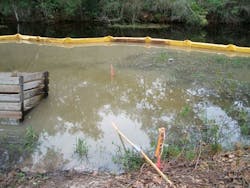About the author: Deodat Budhu is manager, roads and drainage division, for Orange County, Fla. Budhu can be reached at [email protected] or 407.836.7919.
Pocket Lane is a residential roadway located west of Apopka Vineland Road and south of Kilgore Road in southwest Orange County, Fla. An upscale residential area abuts the roadway, which runs approximately 1,500 ft in a north-south direction.
A drainage ditch is located on the east side of Pocket Lane and a shallow swale lies to the west. The drainage ditch flows south along the road, which does not have a defined outfall. Discharge from the affected area is via sheet flow to the Butler Chain of Lakes, which was designated an Outstanding Florida Water.
Severe flooding has been a longtime problem during periods of excessive and cumulative rainfall. Upon review of complaints from local residents about the chronic street flooding, a study of the area was initiated to determine the flooding causes and alternatives to remediate the problem. A consultant was selected to perform this evaluation and provide recommendations.
Existing Problem
The evaluation determined that localized flooding along Pocket Lane resulted from a lack of a positive outlet to the receiving waters. The storage capacity of the shallow swale and soil storage is not adequate to prevent ponding and street flooding, thereby resulting in storm water sheet flowing across private properties to the lake.
The existing drainage system does not appear to have been designed to provide water treatment. The volume that currently is available in the existing ditches above the seasonal high water table is significantly less than the required water quality volume. Furthermore, it can be reasonably expected that the existing drainage ditches will have less storage available during the rainy season given the lack of a recovery mechanism for the stored volume and the anticipated slow infiltration recovery rates due to the shallow seasonal high water table. Therefore, discharge from the existing system to the receiving system is expected to take place via overland flow frequently once the system is saturated.
Proposed Retrofit
Several possible retrofit scenarios that would alleviate the localized flooding were examined, and an alternative that provided water quantity and quality advantages as well as ease of permitting was selected.
This alternative involves improving the existing drainage outflow from the drainage basin, which currently occurs through overland flow to the existing canal system by providing a combined underdrain/exfiltration system to replace the existing drainage ditches and discharge to the existing canal located at the south terminus of the Pocket Lane right-of-way. The system is composed of perforated pipe enveloped in gravel beds that are wrapped in geotextile filter fabric.
The excess runoff beyond the combined underdrain/exfiltration system storage capacity will be discharged over an outfall structure located at the south end of the system and conveyed by 218 ft of 36-in. pipe to the existing canal located at the south terminus of the Pocket Lane right-of-way. The outfall structure will include a 2.75-in. circular bleed-down orifice set at the seasonal high water table elevation of 99 ft, and a 6-ft-wide outflow weir set at an elevation of 100 ft.
In addition to providing conveyance of runoff and discharge to the receiving canal system, the underdrain/exfiltration system will function as a wet detention pond and provide modest water pretreatment for the contributing basin area prior to discharge to the receiving canal system. Proposed swales will be located above the combined underdrain/exfiltration system and will be used to collect runoff from the contributing drainage areas and provide retention with infiltration for water treatment for these areas prior to overflow via raised and grated inlets into the proposed combined underdrain/exfiltration system beneath the swales and eventually outflow to the receiving system.
Addressing Obstacles
The contractor began construction in early 2015, and experienced several challenges throughout the project.
Early on, Orange County Environmental Protection Div. (EPD) staff found turbidity as a result of the work. EPD requested that the contractor provide Florida’s Department of Environmental Protection (FDEP) with groundwater sampling data as well as a dewatering plan to address turbidity and potential pollutants due to the fact that the water discharges to an Outstanding Florida Water.
The project was delayed several weeks in order to test the groundwater and get the results to FDEP for construction commencement approval.
The contractor also faced delays due to issues with the precast concrete pieces. Two of the structures were not wide enough to fit both of the 24-in. HDPE pipe runs and maintain a 2-ft separation, and as a result had to be refabricated.
When the project was substantially completed, the design engineer inspected the completed work and found that one of the structure's slabs was too low and inconsistent with the design plan. This lower slab elevation could cause flow restrictions. The contractor worked with the precast concrete company and surveyors to correct the problem on site.
With regard to the local citizens, there was only one issue, which involved minor damage to a mailbox on the north side of Pocket Lane. The contractor handled the issue and corrected the problem.
Due to the challenges encountered, the project took six months to complete. Despite the challenges and delays, the drainage improvements were accomplished for the betterment of the area. The final cost of design, administration and construction for the project was $498,560.53.
Download: Here


